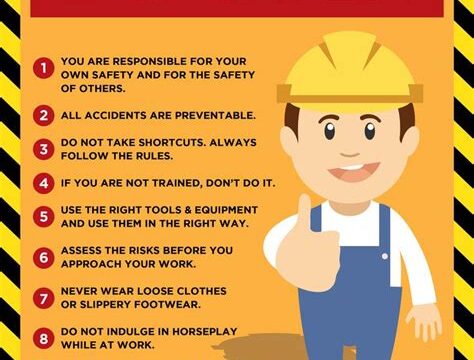When it comes to ensuring a safe and productive work environment, there are a number of essential precautions that every DIY enthusiast or professional should take into consideration. From wearing proper eye protection to implementing an adequate ventilation system, this blog post will cover a range of safety measures that will not only protect you and your workspace but also promote efficiency and organization. Whether it’s safe handling of power tools, fire safety precautions, or proper ladder usage, we’ve got you covered. Additionally, we’ll explore electrical safety measures, emergency preparedness, and first aid protocols. So, let’s dive in and equip ourselves with the necessary knowledge for a secure and successful work environment.
Proper Eye Protection
When it comes to safety in the workplace, one area that is often overlooked is proper eye protection. Whether you work in a construction site, a laboratory, or even just a typical office setting, your eyes are constantly at risk of injury. That’s why it is crucial to understand and implement the necessary precautions to ensure the safety and well-being of your eyes.
First and foremost, it is important to understand the risks associated with not wearing appropriate eye protection. Without proper eye protection, you expose your eyes to various hazards such as flying debris, chemicals, radiation, and even the harmful glare of intense lights. These risks can result in severe eye injuries, including corneal abrasions, chemical burns, retinal damage, and in some cases, permanent vision loss.
So, what can be done to protect your eyes? The most effective way is to wear the appropriate eye protection gear. This includes safety glasses, goggles, or face shields, depending on the specific task or environment you are working in. Safety glasses with side shields are suitable for general eye protection, especially in low-risk situations. On the other hand, goggles should be worn when there is a higher risk of impact or when dealing with hazardous chemicals.
Aside from wearing the right protective gear, it is essential to ensure that the eye protection you use is properly fitted and in good condition. Ill-fitting eyewear may not provide adequate coverage and may even obstruct your vision, further jeopardizing your safety. Regularly inspect your eye protection for any signs of damage or wear, and replace them as necessary to maintain their effectiveness.
In conclusion, proper eye protection is a crucial aspect of workplace safety. By understanding the risks associated with not wearing adequate eye protection and taking the necessary precautions, you can prevent potential eye injuries and safeguard your vision. Remember, protecting your eyes is not just a matter of compliance but also a responsibility to yourself and your overall well-being.
Wear appropriate eye protection gear such as safety glasses, goggles, or face shields.
Ensure the eye protection gear is properly fitted and in good condition.
Regularly inspect and replace the eye protection gear as necessary.
Adequate Ventilation System
When it comes to maintaining a safe and healthy work environment, one often overlooked aspect is the importance of having an adequate ventilation system. A well-designed ventilation system plays a crucial role in removing contaminants from the air, improving air quality, and preventing the buildup of hazardous substances. In this blog post, we will explore the benefits of having proper ventilation in the workplace and discuss some key considerations to keep in mind.
One of the major advantages of an adequate ventilation system is its ability to remove harmful substances and pollutants from the air. In many workplaces, various chemicals, fumes, and dust particles are released during normal operations. Without proper ventilation, these contaminants can accumulate and pose serious health risks to the workers. By effectively ventilating the space, the air can be continuously replaced with fresh air, reducing the concentration of contaminants and providing a healthier working environment.
Another benefit of a well-designed ventilation system is the improvement of overall air quality. Stale and stagnant air can lead to discomfort, drowsiness, and a decrease in productivity. Moreover, poor air quality can cause respiratory issues and allergies, leading to long-term health problems. With adequate ventilation, fresh air is continuously circulated, ensuring a comfortable and pleasant workspace.
- Improved employee productivity: By providing a well-ventilated space, employees are less likely to experience discomfort and fatigue, resulting in increased productivity and efficiency.
- Prevention of health issues: Respiratory problems, allergies, and other health issues caused by poor air quality can be significantly reduced with the use of an effective ventilation system.
- Compliance with regulations: Many occupational health and safety regulations require employers to provide proper ventilation in the workplace. By implementing an adequate system, you can ensure compliance with these regulations and avoid potential penalties.
Now that we understand the benefits, let’s discuss some key considerations for implementing an adequate ventilation system:
| Consideration | Description |
|---|---|
| Identify potential sources of contaminants | Conduct a thorough assessment of the workplace to identify any potential sources of contaminants. This can include chemicals, exhaust fumes, or dust particles. |
| Determine the airflow requirements | Calculate the required airflow based on the size of the workspace and the nature of the contaminants. This will ensure that the ventilation system is capable of effectively removing pollutants. |
| Choose the appropriate ventilation system | Select a ventilation system that is suitable for your specific workplace needs. This can include mechanical ventilation, natural ventilation, or a combination of both. |
| Maintain and regularly inspect the system | Regular maintenance and inspections are essential for ensuring the continued effectiveness of the ventilation system. This includes cleaning filters, checking airflow, and addressing any potential issues. |
In conclusion, an adequate ventilation system is a vital component of a safe and healthy work environment. By effectively removing contaminants, improving air quality, and ensuring employee comfort, a well-designed ventilation system can have significant benefits for both employees and employers. By considering the key considerations mentioned in this blog post, you can ensure that your workplace has an efficient and effective ventilation system in place.
Organized Tool Storage
When it comes to ensuring a safe and efficient work environment, one often overlooked aspect is organized tool storage. Many accidents and injuries occur due to disorganized tools that are not stored properly. Proper tool organization not only helps in improving productivity, but also helps in ensuring safety in the workplace. In this blog post, we will discuss the importance of organized tool storage and the steps you can take to implement it in your workspace.
Having an organized tool storage system offers numerous benefits. Firstly, it allows for easy access to tools when needed. By giving each tool a designated place, you can quickly locate and retrieve them when required, saving valuable time. Additionally, a well-organized storage system helps in preventing tool loss or misplacement, reducing the need for replacing expensive tools.
Moreover, organized tool storage plays a crucial role in maintaining safety in the workplace. When tools are scattered or stored haphazardly, there is a higher risk of accidents occurring. Tools left on the floor or protruding from shelves can lead to trips and falls, causing injuries. By properly storing tools in designated areas, you minimize the chances of accidents and create a clutter-free work environment.
To implement organized tool storage, start by sorting and categorizing your tools. You can create categories based on their type, frequency of use, or any other relevant criteria. Once sorted, invest in a variety of storage solutions like tool chests, pegboards, or wall-mounted racks that best suit your needs. Label each storage area to ensure easy identification and return of tools after use.
- Use sturdy tool chests or cabinets with drawers to store small tools and accessories.
- Hang frequently used tools on a pegboard for quick access and visibility.
- Utilize wall-mounted racks or shelves for larger tools and equipment.
Furthermore, consider implementing a tool check-in and check-out system to keep track of tools and promote accountability among team members. Regularly inspect your storage system to ensure it remains organized and tidy. Remove any damaged or worn-out tools from circulation and replace them as necessary.
| Benefits of Organized Tool Storage | |
|---|---|
| Increased efficiency | Time-saving |
| Reduced risk of accidents | Prevention of tool loss |
| Improved productivity | Clutter-free work environment |
In conclusion, maintaining an organized tool storage system is essential to ensure both productivity and safety in the workplace. By implementing proper categorization, utilizing suitable storage solutions, and promoting accountability, you can create an environment where tools are easily accessible, accidents are minimized, and work efficiency is maximized. So, take the time to organize your tools today and enjoy the benefits it brings to your work environment.
Safe Handling of Power Tools
Power tools are incredibly useful for various DIY and construction projects, but they can also pose potential dangers if mishandled. It is crucial to prioritize safety measures and follow proper guidelines when using power tools to prevent accidents and injuries. Here are some essential tips to ensure safe handling of power tools:
- Familiarize Yourself with the Tool – Before using any power tool, take the time to read the user manual thoroughly. Understand how the tool operates, its limitations, and any safety precautions mentioned by the manufacturer.
- Wear Protective Gear – Always wear appropriate personal protective equipment (PPE) when operating power tools. This may include safety goggles, gloves, ear defenders, and a dust mask. PPE helps protect against flying debris, loud noise, harmful particles, and potential hand or eye injuries.
- Maintain a Clean and Organized Workspace – Keep your work area clean and free from clutter to avoid tripping hazards. Arrange your tools and materials in an organized manner, ensuring that the power cords are safely routed away from sharp edges or moving parts of the tool.
| Power Tool Safety Tips | Description |
|---|---|
| 1. Disconnect Power | When not in use or during tool changes, always disconnect the power source to prevent accidental start-ups. |
| 2. Inspect Before Use | Inspect the tool and power cord for any visible damage or defects. Never use a power tool that appears to be damaged. |
| 3. Use the Right Tool for the Job | Ensure that the power tool you are using is the appropriate one for the task at hand. Using the wrong tool can cause accidents and damage the tool itself. |
Remember, safety should always come first when handling power tools. Be cautious, follow the instructions, and take the necessary precautions to ensure a safe working environment for yourself and those around you. By adopting safe handling practices, you can prevent accidents and greatly minimize the risk of injuries while getting the job done efficiently and effectively.
Fire Safety Precautions
Fire safety precautions are essential for the safety and well-being of everyone, whether at home or in a workplace. Fires can cause significant damage, injuries, and even loss of life. It is crucial to take proactive measures to prevent fires and be prepared in case of an emergency. By implementing the right safety precautions, we can reduce the risk of fire and ensure a safer environment for ourselves and those around us.
One of the first important fire safety precautions is ensuring proper **electrical safety measures**. Faulty electrical wiring and overloaded circuits can easily spark a fire. Regularly check your electrical cords, outlets, and appliances for any signs of damage or wear. Avoid using extension cords for long-term use and make sure to unplug appliances when not in use. It is also crucial to have a fire extinguisher and smoke detectors installed in appropriate locations within your home or workplace.
Another crucial fire safety precaution is creating an effective **emergency preparedness and first aid** plan. Everyone should be aware of evacuation routes and assembly points in case of a fire emergency. Conduct regular drills to ensure that everyone knows what to do in the event of a fire. It is also important to have a fully stocked first aid kit readily available and to ensure that there are trained individuals who can administer first aid if needed.
Proper storage and handling of **flammable materials** is another crucial fire safety precaution. Ensure that flammable liquids and substances are stored in appropriate containers and in a designated storage area away from any ignition sources. Keep the area clean and make sure that flammable materials are properly labeled. It is also important to handle and use flammable materials with caution, following all safety instructions and guidelines provided.
Furthermore, implementing **adequate ventilation systems** is essential in preventing fires. Poor ventilation can cause the accumulation of gases and fumes, increasing the risk of fire. Ensure that all areas have proper ventilation systems in place, especially in areas where hazardous materials are stored or used. Regularly inspect and maintain ventilation systems to ensure their functionality.
In conclusion, fire safety precautions are of utmost importance to protect ourselves, our loved ones, and our properties. By implementing proper electrical safety measures, preparing for emergencies, storing and handling flammable materials appropriately, and ensuring adequate ventilation systems, we can significantly reduce the risk of fires. Remember, fire safety is everyone’s responsibility, and taking proactive measures can save lives and prevent irreplaceable damage.
Proper Ladder Usage
Proper Ladder Usage is essential for ensuring safety in any work environment that requires working at heights. Ladders are commonly used in construction, maintenance, and various other industries to provide access to elevated areas. However, if not used correctly, ladders can pose a significant risk of accidents and injuries. In this blog post, we will explore some important tips and guidelines for using ladders safely.
First and foremost, it is crucial to select the right ladder for the job. Different tasks may require different types of ladders, such as step ladders, extension ladders, or platform ladders. The ladder should be sturdy, in good condition, and capable of supporting the weight of the user and any equipment or materials being carried. Before using a ladder, always inspect it for any visible defects, such as loose or missing rungs, cracked or damaged parts, or wobbly joints. If there are any abnormalities, the ladder should not be used and should be reported for repair or replacement.
Next, it is important to set up the ladder correctly. Make sure to place the ladder on a stable and level surface. If the ground is uneven, use appropriate equipment like ladder levelers or leg extenders to provide stability. Ensure that the ladder is fully extended and locked in position before climbing. If using an extension ladder, the top of the ladder should extend at least three feet above the landing or working level to ensure a secure grip while transitioning on and off the ladder.
Furthermore, maintaining three points of contact with the ladder at all times is vital for stability and preventing falls. This means either having two hands and one foot, or two feet and one hand on the ladder rungs while ascending or descending. Avoid overreaching or leaning too far to either side, as it can cause the ladder to become unbalanced and potentially tip over. Instead, reposition the ladder as needed to maintain a safe working position. Additionally, never attempt to move or shift a ladder while someone is on it. It should always be properly secured before use.
By following these proper ladder usage guidelines, workers can significantly reduce the risk of accidents and injuries. Remember, safety should always be the top priority when working at heights. Taking the time to choose the right ladder, inspect it for any defects, set it up correctly, and maintain proper contact and balance will go a long way in ensuring a safe working environment.
Electrical Safety Measures
When it comes to electrical safety, it is vital to prioritize precautions in order to prevent accidents and potential risks. Electricity is a powerful force that requires careful handling and maintenance to ensure the safety of individuals and property. By implementing a series of safety measures and practices, the risk of electrical hazards can be significantly reduced.
One of the most important steps in electrical safety is to have adequate insulation for all electrical installations. Insulation acts as a barrier, preventing electricity from flowing to unintended pathways and minimizing the risk of electric shocks or short circuits. It is crucial to ensure that all wires, cables, and electrical devices are properly insulated to prevent accidental contact with live electrical components.
In addition to insulation, another essential safety measure is proper grounding. Grounding provides a direct pathway for electrical current to flow safely into the earth, protecting individuals and preventing damage to electrical systems. Ensuring that the electrical system is properly grounded is essential, especially in areas where there is a higher risk of electrical overload or surge.
Furthermore, regular maintenance and inspection are crucial for electrical safety. This involves periodic checks for damaged cables or wires, loose connections, and faulty equipment. Any signs of wear and tear should be addressed immediately to avoid potential hazards. It is recommended to have routine inspections conducted by a professional electrician to ensure the ongoing safety and reliability of the electrical system.
- Check for proper insulation on all electrical components.
- Ensure proper grounding of the electrical system.
- Regularly inspect and maintain electrical installations.
- Properly label electrical panels and circuits for easy identification.
| Electrical Safety Measures |
|---|
| Proper Insulation |
| Ensure all wires, cables, and electrical devices are properly insulated to prevent accidents and potential electric shocks. |
| Proper Grounding |
| Ensure the electrical system is properly grounded to provide a safe pathway for electrical current and prevent electrical overload or surge. |
| Regular Maintenance and Inspection |
| Regularly inspect and maintain electrical installations, checking for any signs of wear and tear, loose connections, or faulty equipment. |
By implementing these electrical safety measures, individuals can minimize the risk of electrical accidents, shocks, and fires. It is important to remember that electricity should always be treated with caution and respect. Taking the necessary precautions and staying informed about electrical safety practices can help create a secure and reliable electrical environment.
Emergency Preparedness and First Aid
Emergency preparedness and first aid are crucial aspects in ensuring the safety and well-being of individuals in any situation. Whether it is a natural disaster, a workplace accident, or a medical emergency, being prepared and having the necessary first aid knowledge can make a significant difference in mitigating the impact of such incidents. In this blog post, we will delve into the importance of emergency preparedness and the key elements of first aid that everyone should be aware of.
One of the most important aspects of emergency preparedness is having a well-established plan in place. This includes identifying potential hazards and risks, developing evacuation procedures, and providing clear guidelines for employees or family members. A well-documented plan allows for a swift and orderly response during an emergency situation. Regular drills and training sessions should be conducted to ensure that everyone is familiar with the plan and understands their roles and responsibilities.
Another essential component of emergency preparedness is having a well-stocked first aid kit. The first aid kit should contain basic medical supplies such as bandages, antiseptic solutions, adhesive tape, scissors, and gloves. It is important to regularly check and replenish the supplies to ensure that they are not expired or depleted. In addition to the first aid kit, it is also crucial to have emergency contact numbers readily available, including the nearest hospital, ambulance service, and poison control center.
- Proper Eye Protection
- Adequate Ventilation System
- Organized Tool Storage
- Safe Handling of Power Tools
- Fire Safety Precautions
- Proper Ladder Usage
- Electrical Safety Measures
| Emergency Contacts | Contact Details |
|---|---|
| Hospital | Emergency Hospital Phone Number |
| Ambulance | Emergency Ambulance Phone Number |
| Poison Control Center | Poison Control Center Phone Number |
Knowing first aid skills can save lives in emergency situations. Basic techniques such as CPR (cardiopulmonary resuscitation), the Heimlich maneuver, and how to stop bleeding are essential skills that could make a significant difference until professional medical help arrives. Additionally, everyone should be familiar with the signs and symptoms of common medical emergencies, such as heart attacks, strokes, and allergic reactions, and know how to respond appropriately.
Remember, emergency preparedness and first aid are not limited to specific environments. Whether you are at home, in the workplace, or even outdoors, having the knowledge and resources to handle emergencies can protect both yourself and those around you. Taking the time to educate yourself and others on the fundamentals of emergency preparedness and first aid can ultimately make a significant difference in saving lives.
Frequently Asked Questions
Question 1: Why is proper eye protection important?
Proper eye protection is important because it helps prevent injuries such as eye strain, irritation, and more serious damage caused by flying debris, chemicals, or particles during various tasks.
Question 2: What are the benefits of an adequate ventilation system?
An adequate ventilation system helps improve indoor air quality by removing pollutants, reducing the risk of respiratory problems, and providing a comfortable working environment with fresh air circulation.
Question 3: How does organized tool storage contribute to safety?
Organized tool storage helps prevent accidents by reducing clutter and maintaining a clean workspace. It minimizes the risk of tripping or falling due to scattered tools and enables easier access, ensuring tools are kept in their proper place.
Question 4: What are some safe handling practices for power tools?
Safe handling of power tools involves following manufacturer instructions, wearing appropriate safety gear, maintaining a firm grip, inspecting tools for damage, and using them according to their intended purpose. Regular maintenance and proper storage are also crucial.
Question 5: What are some fire safety precautions to consider?
Fire safety precautions include having functional fire extinguishers nearby, keeping flammable materials stored properly, ensuring proper wiring and electrical connections, and conducting regular fire drills to ensure everyone knows evacuation procedures.
Question 6: How should ladders be used safely?
Ladders should be used safely by ensuring they are in good condition, setting them on stable surfaces, maintaining three points of contact while climbing, and not overreaching. Additionally, it’s important to use the correct ladder type and follow weight capacity guidelines.
Question 7: What electrical safety measures should be taken?
Electrical safety measures include avoiding overloading circuits, using grounded outlets, keeping cords in good condition, using ground fault circuit interrupters (GFCIs) in wet areas, and hiring licensed electricians for any installations or repairs.





